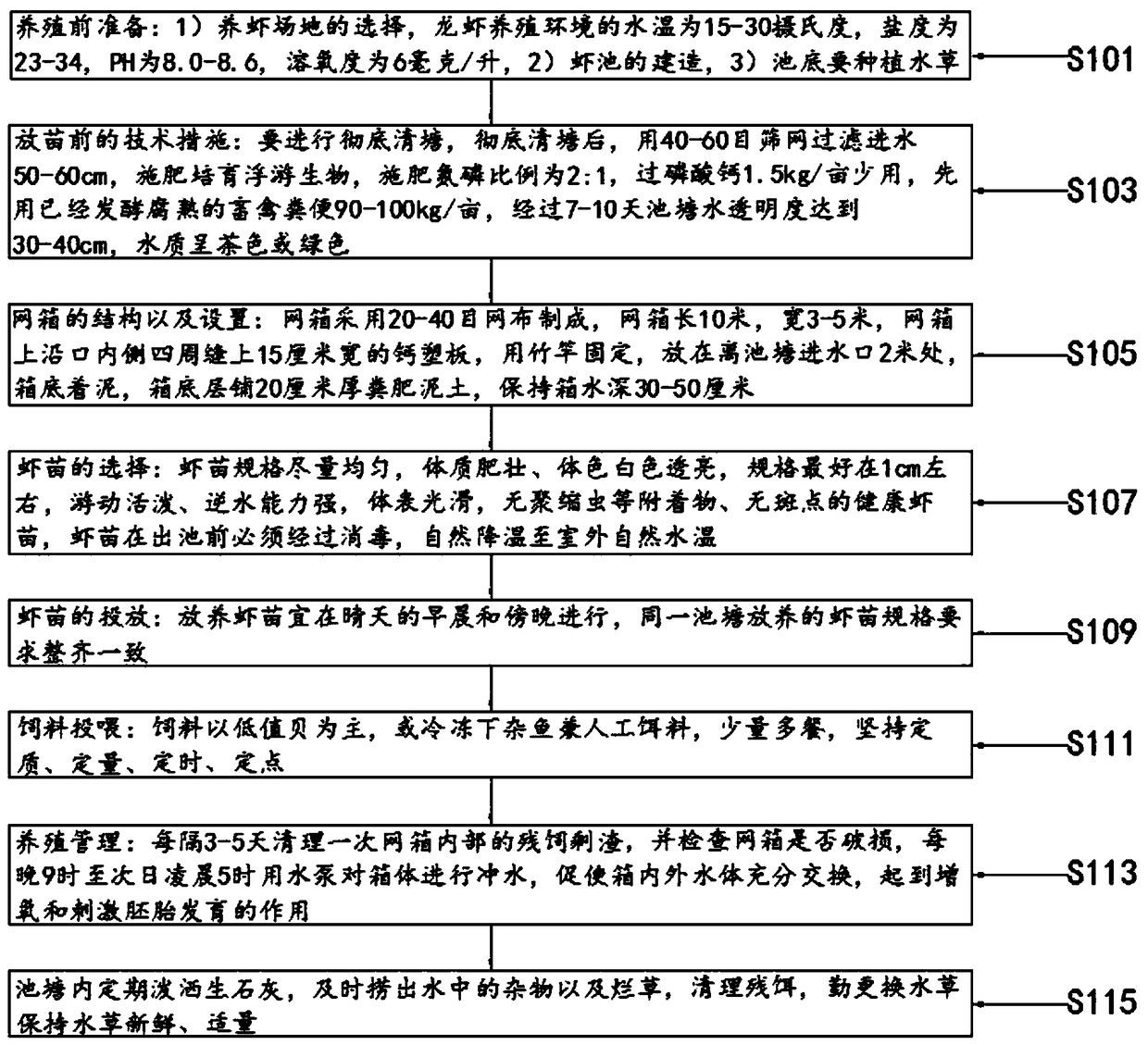Sea water net cage hanging culture method for lobster
A breeding method and net cage technology, which is applied in the field of lobster seawater cage culture, can solve the problems of low efficiency of lobster culture, achieve the effects of preventing lobster diseases, green and safe protein content, and improving survival rate and yield
- Summary
- Abstract
- Description
- Claims
- Application Information
AI Technical Summary
Problems solved by technology
Method used
Image
Examples
Embodiment 1
[0032] Embodiment one, such as figure 1 As shown, according to an embodiment of the present invention, a seawater cage culture method for lobsters, comprising the following steps:
[0033] S101, preparation before breeding: 1) selection of shrimp farming site, water temperature of lobster farming environment is 15-30 degrees Celsius, salinity is 23-34, pH is 8.0-8.6, dissolved oxygen is 6 mg / L, 2) shrimp The construction of pond, 3) aquatic plants will be planted at the bottom of the pond;
[0034] S102, technical measures before releasing seedlings: Thoroughly clear the pond. After thoroughly clearing the pond, use a 40-60 mesh screen to filter the incoming water for 50-60cm, fertilize and cultivate plankton, and fertilize with a ratio of nitrogen and phosphorus of 2:1 and superphosphoric acid. Use less calcium than 1.5kg / mu, first use 90-100kg / mu of fermented and decomposed livestock and poultry manure, after 7-10 days, the transparency of the pond water will reach 30-40cm,...
Embodiment 2
[0041] Embodiment 2. The construction of the shrimp pond can be used as a clear pond with quicklime water for newly-built lobster ponds, and 100 kilograms per mu is used. If the old ponds or lakes are used to raise lobsters, dredging, trimming, and exposure to the sun are required. For 10-15 days, use 50 kg of quicklime per mu to sterilize the dry pond, and at the same time completely remove catfish, loach, black fish, snakes, rats and other predatory wild predators in the pond; cleaning the pond can reduce pollution, thereby reducing shrimp seedlings. The pollution is more conducive to the healthy growth of shrimp seedlings.
Embodiment 3
[0042] Embodiment three, the species of the planted aquatic plants include Hydra verticillium, Elodea, bitter grass, water peanuts, etc. The planted area accounts for 20% to 30% of the cultured area, and the aquatic plants in the net cage account for about 50% of the entire net cage area ; Because aquatic plants are the subsidy and natural bait that the shrimp body can survive and survive, it can also purify the pool water and absorb the lobster feces to treat the water quality and fertility.
PUM
 Login to View More
Login to View More Abstract
Description
Claims
Application Information
 Login to View More
Login to View More - R&D
- Intellectual Property
- Life Sciences
- Materials
- Tech Scout
- Unparalleled Data Quality
- Higher Quality Content
- 60% Fewer Hallucinations
Browse by: Latest US Patents, China's latest patents, Technical Efficacy Thesaurus, Application Domain, Technology Topic, Popular Technical Reports.
© 2025 PatSnap. All rights reserved.Legal|Privacy policy|Modern Slavery Act Transparency Statement|Sitemap|About US| Contact US: help@patsnap.com

